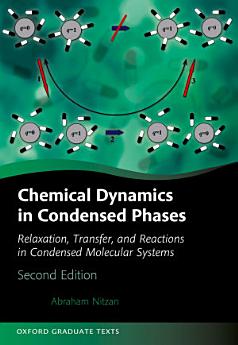Chemical Dynamics in Condensed Phases: Relaxation, Transfer, and Reactions in Condensed Molecular Systems, Edition 2
Abraham Nitzan
Jul 2024 · Oxford University Press
5.0star
1 reviewreport
Ebook
784
Pages
family_home
Eligible
info
reportRatings and reviews aren’t verified Learn More
About this ebook
This second edition of Chemical Dynamics in Condensed Phases provides a substantial modification and expansion of the first edition published in 2006. Nitzan offers a uniform approach to diverse problems encountered in the study of dynamical processes in condensed phase molecular systems. The textbook focuses on three themes: contextual background material, in-depth introduction of methodologies, and analysis of several key applications. These applications are among the most fundamental processes that underlie physical, chemical, and biological phenomena in complex systems. The comprehensive, advanced, and self-contained text provides the theoretical foundations for the processes affecting molecular dynamics in condensed phases that are encountered in the chemistry laboratory as well as in biology and material science research. The mathematical tools and the physical concepts necessary to develop the chemical description are provided first, followed by a detailed discussion of the fundamental chemical processes that underlie the chemical dynamics, including quantum and classical aspects of molecular motion and the interaction of molecules with the radiation field and the surrounding thermal environment. The last part of the book discusses several key processes: accumulation and relaxation of molecular energy, chemical reaction dynamics and the interplay of these dynamics with the dynamics and relaxation of the surrounding solvent, electron transfer reactions, electrode processes and molecular conduction junctions as well as molecular response to optical stimuli in solution and at dielectric interfaces. Attention is given to combining the mathematical analysis with qualitative physical understanding of the different dynamical phenomena. New to this edition is a new chapter 19 on the interaction of molecules with light at dielectric interfaces, motivated by the surge of interest in molecular plasmonics and molecular cavity electrodynamics, as well as a section relevant to this issue added to Chapter 10. Chapters on light-matter interaction and spectroscopy have been expanded to include subjects relevant to the foundation and practice of interfacial spectroscopy. Sections have also been added to include discussion of noise and fluctuations observed in single molecule spectroscopy and in molecular junction transport.
Ratings and reviews
5.0
1 review
About the author
Abraham Nitzan (b Israel in 1944) has worked Tel Aviv University since 1975 and is now a Professor of Chemistry and Donner Professor of Physical Science at the University of Pennsylvania. His research is focused on chemical and photochemical processes and charge and energy transfer in condensed phases and interfaces. Among his main recognitions are the Israel Chemical Society Prize (2004) and Medal (2015), the Emet Prize, the APS Plyler Prize, the ACS Theoretical Chemistry Prize and the Israel Prize in Chemistry. He is a member of the American Academy of Arts and Sciences, a Foreign Associate of the US National Academy of Sciences and a member of the Israel Academy of Arts and Sciences.
Rate this ebook
Tell us what you think.
Reading information
Smartphones and tablets
Install the Google Play Books app for Android and iPad/iPhone. It syncs automatically with your account and allows you to read online or offline wherever you are.
Laptops and computers
You can listen to audiobooks purchased on Google Play using your computer's web browser.
eReaders and other devices
To read on e-ink devices like Kobo eReaders, you'll need to download a file and transfer it to your device. Follow the detailed Help Center instructions to transfer the files to supported eReaders.




